Reliable WiFi is a top priority for RV park guests, but for one small park owner, it was a constant headache. Covering a 300ft x 300ft area with fewer than 20 spaces, his existing setup kept failing, leading to frequent complaints from guests who wanted seamless streaming and reliable connectivity.
The Challenge: Unstable Network & Limited Technical Expertise
The owner struggled with unreliable equipment that frequently went down. He wasn’t a tech expert, but he could handle the installation—he just needed the right equipment and real support from a company that would answer the phone and guide him through the setup.
The Solution: A High-Quality, Integrated Access Point
GNS Wireless recommended a commercial-grade integrated access point with cloud-based management, providing:
- Strong, Reliable Coverage – Eliminates dead zones and supports multiple devices per site.
- Streaming-Ready Performance – Guests can enjoy Netflix, YouTube, and video calls without buffering.
- Easy Installation – Comes with mounting hardware for quick setup.
- Cloud Access for Remote Management – Monitor and adjust settings from anywhere.
- Long-Term Reliability – Backed by a 2-year warranty for peace of mind.
Where Should Access Points Be Installed for the Best Signal?
1. Height: Is Higher Always Better?
-
Yes, but with limits. Mounting APs higher helps to extend the signal and reduce obstructions.
-
However, too high (like on a very tall pole) can weaken signals for devices on the ground due to the downward signal pattern.
-
A good height range is 15 to 25 feet above ground for outdoor APs and for parks that have a fairly level elevation.
2. Trees: Friend or Foe?
-
Trees block WiFi signals! Dense foliage absorbs and scatters signals, reducing range.
-
Solution: Place APs above or around trees whenever possible, or use multiple units to work around them.
3. Hills & Uneven Terrain
-
WiFi signals struggle with elevation changes, as hills block line-of-sight.
-
Solution:
-
Install APs at multiple levels to provide coverage in valleys.
-
Consider directional antennas pointing down slopes or towards key coverage areas.
-
4. Best Placement Strategy for Campgrounds
- Central & Elevated Locations: Cover the largest area with the fewest APs.
- Line of Sight: Avoid placing APs where hills, trees, or buildings block the signal.
- Multiple APs for Large Areas: Instead of one powerful AP, use multiple strategically placed units.
- Weatherproof Enclosures: Ensure APs are outdoor-rated for durability.
The Result: Happy Guests & Worry-Free WiFi
With the new integrated access point installed, the RV park now enjoys stable, high-performance WiFi. Guests are satisfied, and the owner no longer dreads service calls. Plus, with GNS Wireless’ expert U.S.-based support, he knows help is just a phone call away.
Get Reliable WiFi for Your Campground Today!
Don’t let weak WiFi drive your customers away. Whether you need a single access point or a full-scale campground network, GNS Wireless has the expertise and equipment to get you connected. We provide real U.S.-based support, helping you every step of the way—from selecting the right hardware to installation and setup.
📞 Call us today at (877) 209-5152!
🌐 Visit www.gnswireless.com to learn more!

